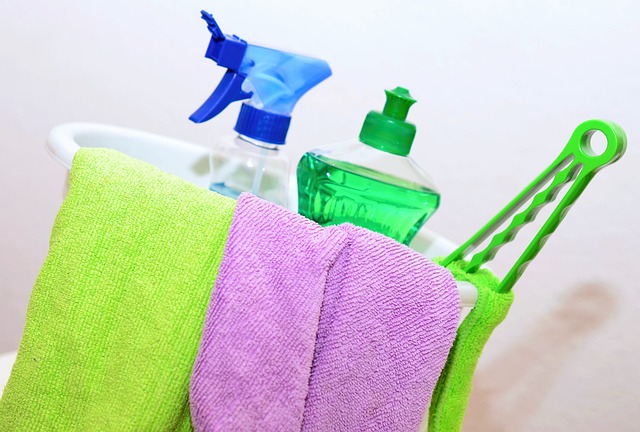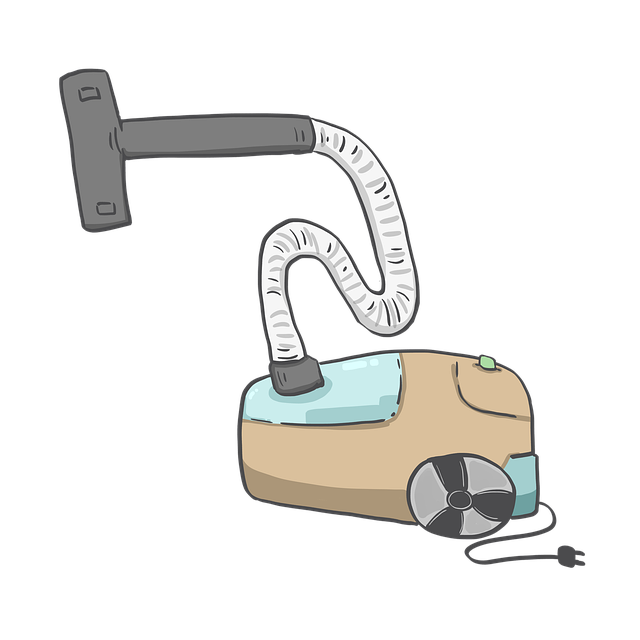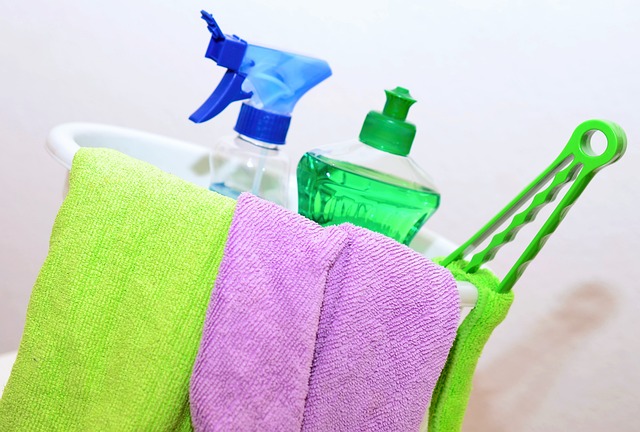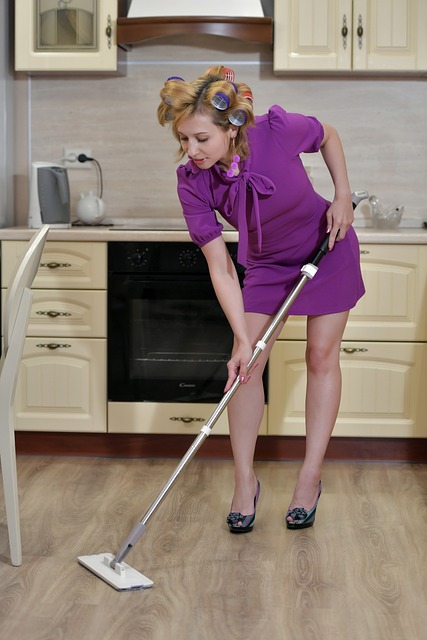To effectively clean a kitchen floor, first identify the material (tile, vinyl, wood, linoleum) for suitable care. Use appropriate tools like a vacuum, steam mop, microfiber cloths, and natural solutions like vinegar and baking soda. Prioritize safety while cleaning. Deep clean weekly with a mild detergent, focusing on traffic areas and stains. Maintain floors daily by sweeping/vacuuming and spot-cleaning spills promptly. For eco-friendly cleaning, use vinegar, baking soda, essential oils; these are cost-effective, safe, and versatile. Consider professional kitchen floor cleaning services for thorough disinfection and tailored solutions in commercial kitchens.
Keeping your kitchen floor clean is essential for a hygienic and aesthetically pleasing space. This comprehensive guide will walk you through the process of deep cleaning, maintaining, and revitalizing your kitchen floors. From understanding various floor surfaces to employing effective cleaning methods and natural solutions, we cover it all. Learn how regular maintenance and spot treatment can prevent stains and discoloration, ensuring your kitchen floor remains a centerpiece for years to come. Discover the benefits of professional services for a truly remarkable result.
Understanding Your Kitchen Floor Surface

Before tackling any kitchen floor cleaning task, it’s crucial to understand your floor surface. Different materials require distinct care approaches. Whether your kitchen boasts tile, vinyl, wood, or linoleum, each has unique characteristics and maintenance needs. For instance, porous surfaces like wood need regular sealing to protect against moisture and stains, while non-porous materials like tile are generally easier to maintain.
Identifying your floor type allows for the selection of appropriate cleaning products and techniques. Using the wrong cleaner on a delicate surface could cause damage or discoloration. Conversely, the right cleaning tools and solutions can enhance the floor’s appearance, ensuring a sparkling and healthy kitchen environment.
Tools and Equipment for Effective Cleaning

When it comes to efficient kitchen floor cleaning, the right tools and equipment make all the difference. Start with a high-quality vacuum cleaner designed for hard floors; this will effectively remove embedded dirt and debris, especially in corners and under cabinets. For deeper cleaning, invest in a good quality steam mop. Steam mops kill bacteria and germs while leaving your floors sparkling clean. Microfibre cloths are essential for spot cleaning and wiping down surfaces, as they trap dust and grime without leaving scratches.
Don’t underestimate the power of natural cleaning solutions like vinegar and baking soda. These simple, cost-effective ingredients can be used to make powerful floor cleaners that are safe for both your family and the environment. Always remember to wear protective gear, such as knee pads and gloves, especially when handling harsh chemicals or scrubbing floors intensively.
Steps for Deep Cleaning Your Kitchen Floor

Deep cleaning your kitchen floor involves several strategic steps to ensure a thorough and effective clean. Start by sweeping or vacuuming the floor to remove any loose dirt, debris, or food particles. This initial step is crucial for preparing the surface for a deeper clean. Next, mix a mild detergent with warm water, creating a solution that’s gentle enough not to damage the flooring but powerful enough to loosen stains and grime. Apply this solution using a mop or sponge, focusing on areas with heavy traffic or stubborn marks.
For tough stains, consider using a specialized cleaning product designed for kitchen floors. Scrub gently but firmly with a clean cloth or brush, ensuring you reach all corners and edges. Rinse the floor thoroughly to remove any residual detergent, preventing soap scum from forming. Finally, dry the floor completely using a microfiber towel or allow it to air-dry, leaving your kitchen floor sparkling clean and ready for daily use.
Regular Maintenance Tips for Longevity

Regular maintenance is key to keeping your kitchen floor clean and durable for years to come. Start by sweeping or vacuuming your kitchen floor daily to remove loose dirt, debris, and spills, which can prevent grinding and damage over time. This simple step goes a long way in maintaining the cleanliness and longevity of your flooring.
Additionally, consider using a mild detergent or all-purpose cleaner once a week to deep clean your kitchen floor. Avoid harsh chemicals as they can strip away the protective coating on your floor, leading to discoloration and premature wear. Always spot-clean any spills immediately to prevent staining and use mats at entryways to reduce the amount of dirt tracked onto your floors. These consistent care practices will ensure your kitchen floor remains in pristine condition and save you from costly repairs down the line.
Dealing with Common Stains and Discolorations

When it comes to kitchen floor cleaning, addressing common stains and discolorations is an essential part of maintaining a fresh and inviting space. Over time, various factors can contribute to unsightly marks on your kitchen floors, from spills and tracks from wet appliances to foot traffic and dirt tracked in from outside.
Fortunately, many stains can be treated effectively with simple household solutions. For instance, light stains caused by food or water can often be removed using warm soapy water and a soft-bristled brush. More persistent marks, such as those from grease or coffee, might require a mild acid-based cleaner or a specialized floor cleaning product designed for kitchen use. Regular mopping and immediate attention to spills can significantly reduce the occurrence of these issues, ensuring your floors remain in top condition.
Using Natural Cleaning Solutions

When it comes to kitchen floor cleaning, opting for natural solutions is an eco-friendly and healthy choice. Many conventional cleaning products contain harsh chemicals that can leave residues and potentially impact indoor air quality. Instead, consider using vinegar, baking soda, and essential oils as powerful alternatives. White vinegar, for instance, is an excellent disinfectant and deodorizer, while baking soda acts as a gentle abrasive to scrub away stubborn stains. Essential oils like lemon or tea tree add a refreshing scent without harmful fumes.
These natural ingredients are not only cost-effective but also versatile. A simple mixture of equal parts vinegar and water can clean and shine your kitchen floors. For more targeted cleaning, add a few drops of essential oil to the solution for an aromatic twist. Baking soda can be used dry to absorb excess moisture and freshen the air, or mixed with water to create a paste for scrubbing hard-to-reach areas and marks left by spills.
The Benefits of Professional Kitchen Floor Cleaning Services

Professional kitchen floor cleaning services offer a multitude of benefits that go beyond basic hygiene. In a commercial setting, where kitchens are bustling hubs of activity, regular cleaning can be challenging to maintain with in-house staff alone. Professional cleaners have the equipment and expertise to thoroughly clean and disinfect every corner, including hard-to-reach areas under appliances and along baseboards. This ensures not just a sparkling floor but also creates a hygienic environment, reducing the risk of cross-contamination that could affect food quality and customer health.
Moreover, professional services can tailor their cleaning solutions to your kitchen’s specific needs. Whether it’s a tile floor requiring specialized cleaning products or a wood floor needing gentle yet effective treatment, experts will use the right tools and chemicals. Regular professional cleaning also extends the lifespan of your kitchen floors by removing stubborn stains, preventing damage from chemical buildup, and protecting against scuffs and scratches. This not only preserves the aesthetic appeal but also maintains the value of your property.
